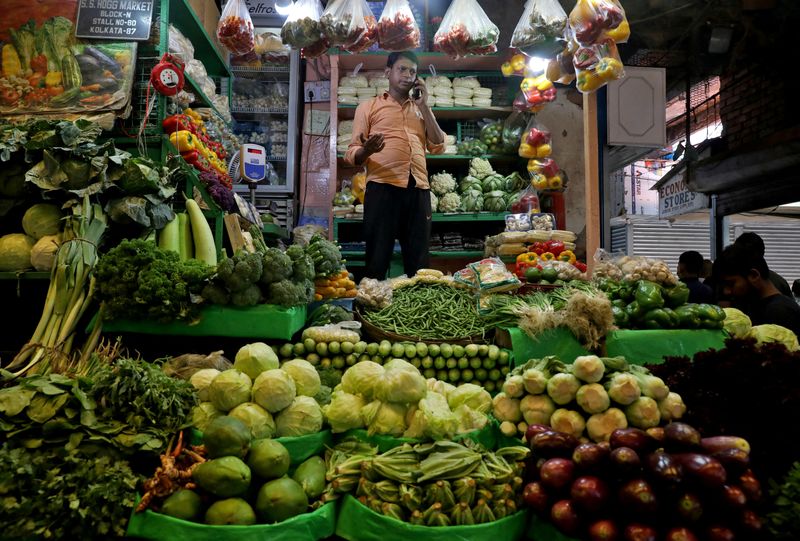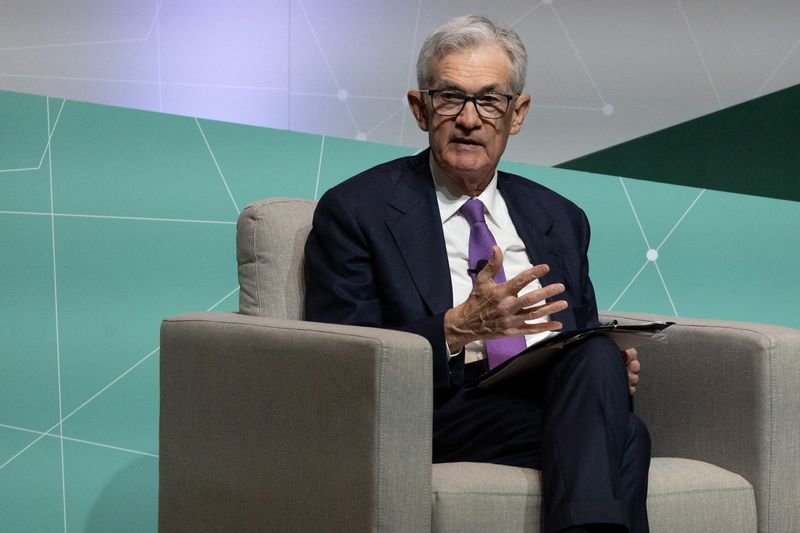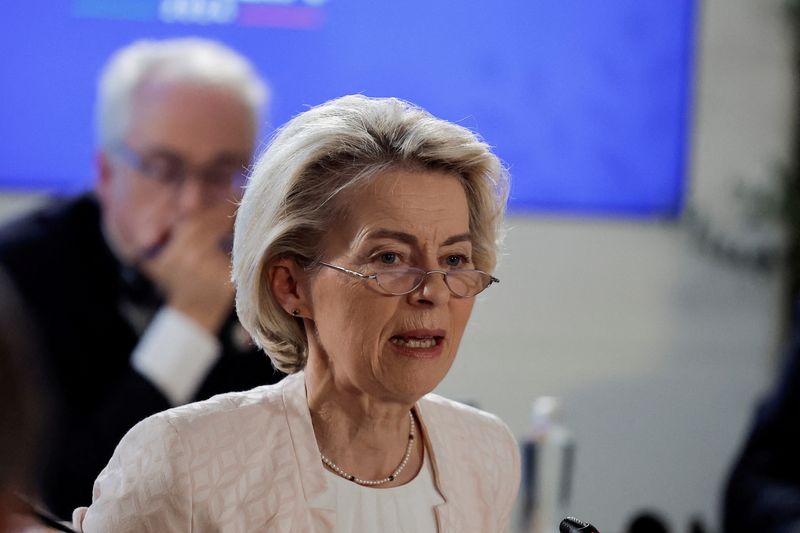Select Language

MUMBAI (Reuters) - India is expected to grow by 7.2% in the current fiscal year, stronger than earlier expected, with its central bank opting for just a one-quarter-point rate cut in that period, Fitch Ratings said in its quarterly Global Economic Outlook (GEO) report published on Tuesday.
The ratings agency has also raised its world growth forecast for 2024 to 2.6% from 2.4% earlier as confidence in European recovery prospects improve, China's export sector revives and domestic demand in emerging markets excluding China shows stronger momentum.
"We still expect the RBI to cut its policy rate this year, but only once, to 6.25%. In the March GEO we expected 50 basis points of cuts this year. We then expect 25 bps of cuts in both 2025 and 2026," Fitch wrote.
India's growth forecast marks an upward revision of 0.2 percentage points versus their March forecast.
"Investment will continue to rise but more slowly than in recent quarters, while consumer spending will recover with elevated consumer confidence," Fitch said about India.
The agency, however, expects growth to slow in later years and approach their medium term trend estimate.
"We forecast real GDP growth of 6.5% in FY25/26 (unchanged from March), and 6.2% in FY26/27, driven by consumer spending and investment," they wrote.
Fitch expects headline inflation in the South Asian nation to continue declining to 4.5% by calendar year-end, and average 4.3% in 2025 and 2026, staying slightly above the mid-point of the Reserve Bank of India's 2% to 6% target range.

SEOUL (Reuters) - South Korea's central bank governor said on Tuesday the pace of consumer inflation is likely to continue to slow, feeding expectations the Bank of Korea will start cutting interest rates towards the end of this year.
"Considering the recent slowdown in international oil and agricultural product prices, future prices are expected to continue a gradual slowdown, in line with our May forecasts," Governor Rhee Chang-yong said in a statement prepared for the bank's biannual review of inflation conditions.
Inflationary pressure from domestic demand is likely to stay contained, while exports growth is expected to take the driver's seat in the economy seen growing 2.5% this year, he added.
Tuesday's assessment supports analysts consensus that the BOK will cut interest rates by 50 basis points in the fourth quarter as headline inflation is seen easing to its target rate of around 2% towards the end of this year or early next year.
The BOK extended its interest rate pause for an 11th straight meeting in May, keeping it restrictive after raising rates by a cumulative 300 basis points to 3.50% since mid-2021.
South Korea's headline inflation slowed for a second straight month to a 10-month low of 2.7% in May, while core inflation also eased to 2.2% from 2.3% in April.
The BOK also noted that although inflation is headed towards its target rate of 2%, the cost of living in Asia's fourth largest economy remains elevated compared to other major countries.
An index for the cost of food, shelter and clothes was at 155 for South Korea in 2023, above the average of 100 for countries in the Organisation for Economic Co-operation and Development, data compiled by BOK showed.

By Naveen Thukral
SINGAPORE (Reuters) -Pork suppliers from South America and the U.S. could gain market share in China if Beijing restricts imports from the European Union in response to escalating trade tensions, traders and analysts said.
Russia, increasingly a close trading partner of China that started exporting pork to China in February, could also step up meat shipments.
China's commerce ministry said on Monday it had opened an anti-dumping investigation into imported pork and its by-products from the EU, after the bloc imposed anti-subsidy duties on Chinese-made electric cars.
Any impact on EU exports will take time to emerge. China has said the investigation could last more than a year.
"Brazil, Argentina and the U.S. can export more pork and offal to China if exports from the European Union are restricted," Pan Chenjun, a senior analyst at Rabobank in Hong Kong, said.
"If the anti-dumping tax is too high, than shipments from other origins such as the US, Brazil and Argentina will increase."
The U.S. Meat Export Federation (USMEF) noted U.S. pork faces retaliatory duties of 25% in China in response to steel and aluminum tariffs, however.
"It is unclear whether U.S. pork will still be at a tariff disadvantage compared to EU pork, as is the case today," said Joe Schuele, vice president of communications for the USMEF.
Smithfield Foods, a unit of Hong Kong-listed WH Group (OTC:WHGLY) ltd, is familiar with the impact of Chinese tariffs on U.S. pork and would welcome relief on that front, spokesman Jim Monroe said.
Anti-dumping duties could hit Europe hard as China's pork purchases from Europe include parts such as feet, ears and offal that tend to only be used for pet food rather than human consumption in Europe.
Pan, however, said any impact on China's market would be limited.
"We don't see much impact on the local market in terms of supplies and prices if imports are restricted from the European Union. This is because China's imports of pork and offal are just 5% of total consumption," Pan said.
USMEF's Schuele said there could be further opportunities for U.S. pork variety meats in China, including feet, stomachs, heads and neckbones.
LEADING CONSUMER AND PRODUCER
In 2023, China imported $6 billion worth of pork, including offal, customs data showed.
It is the world's leading pig producer and consumes around half the world's pork.
Domestic hog prices had plummeted, but oversupply has eased this year as farmers slaughtered fewer pigs to boost the market.
One Asia-based trader who deals in animal feed said Brazil, China's leading agricultural trading partner, stood to gain from any EU trade disruption.
The trader, who asked not to be named because they were not authorised to speak to the press, said Brazil was very competitive in terms of pricing and would be able to easily increase market share.
Russia also has potential for growth, and according to Yuri Kovalev, head of the country's National Union of Pork Producers, it wants a 10% share of China's pork imports within three to four years.
As of June 2, Russia's pork shipments to China totalled 4,260 metric tons, but Sergey Dankvert, the head of Rosselkhoznadzor, Russian agricultural watchdog, said earlier this month Russia could export up to 100,000 tons of pork to China in 2024.
The head of Miratorg, one of Russia's major pork suppliers, Viktor Linnik told an investment forum in St. Petersburg that the agricultural holding was ready to supply China with about 40,000 tons of pork by the end of the year.
One meat trader in Shanghai, who asked not to be named, said his company was in contact with Russian pork exporters.

By Ann Saphir
(Reuters) -U.S. Federal Reserve Chair Jerome Powell is scheduled to give his semiannual testimony on monetary policy on July 9 at the Senate Banking Committee, the office of Senator Sherrod Brown, the committee's chair, said on Monday.
If scheduling proceeds as it has historically, Powell would deliver the same testimony at the House Financial Services committee the following day. Spokespeople for that committee did not immediately respond to a request for information.
Both hearings are typically hours-long affairs, with lawmakers from both sides of the aisle grilling Powell on a range of topics from interest-rate policy to the state of the banking system.
Powell was first appointed as Fed Chair by former president Donald Trump and reappointed for a second term by President Joe Biden. At all turns he seeks to assert the central bank's independence from politics, with any interest-rate decisions driven entirely by the state of the economy.
The Fed last week kept the policy rate in the 5.25%-5.5% range, and signaled it may cut borrowing costs only once this year.
If that forecast - which assumes slow downward progress on inflation and no big cracks in the labor market - pans out, the Fed could be expected to remain on the sidelines until after the November presidential election.
Brown and other Democrats have called on the Fed to cut rates to make homes more affordable. A rate cut before the election could help Biden, a Democrat, in his rematch against Trump, a Republican who has said that he thinks the Fed may lower interest rates to help sway the election.

By Andrew Gray and Jan Strupczewski
BRUSSELS (Reuters) - European Union leaders ended a discussion on who should take the bloc's top jobs for the next five years without agreement on Monday, aiming instead for a decision at a summit next week.
The leaders' meeting was the first since the European Parliament election, which saw gains for the centre-right and right-wing nationalists, but humiliating defeats for French President Emmanuel Macron and German Chancellor Olaf Scholz.
Over dinner in Brussels, the EU's 27 national leaders discussed who should run the powerful European Commission executive body, who should chair their European Council meetings and who should take the post of foreign policy chief.
They had been widely expected to nominate Ursula von der Leyen of Germany for a second term as European Commission chief, Portuguese ex-premier Antonio Costa as Council president and Estonian Prime Minister Kaja Kallas as top diplomat.
But the current European Council president, Charles Michel, said they needed more time.
"It was a good conversation, (it) goes in the right direction, I think. But there is no agreement tonight," he told reporters after the dinner.
Michel said pan-European political parties had made proposals about the posts and more work would be needed to reach an agreement. He did not elaborate on the proposals.
POLE POSITION
Von der Leyen remains in pole position to stay on as European Commission president, buoyed by gains in the June 6-9 elections for her centre-right European People's Party.
Thirteen of the 27 EU leaders are from parties belonging to the EPP. With French and German support too, she would have the qualified majority she requires to be nominated.
France had previously weighed alternatives to von der Leyen, but with a snap parliamentary election called by Macron from June 30, the government now prefers EU stability. Germany has made clear it backs von der Leyen for another term.
A trio of von der Leyen, Costa - a veteran socialist - and liberal Kallas would ensure a political and geographical balance among the top posts.
The leaders are due to make a formal decision at a summit on June 27-28. Von der Leyen would still then need backing from the European Parliament, which votes in its first session from July 16.
The full 27-member Commission, including the foreign policy chief, also needs parliamentary support.
The leaders also discussed the next five-year legislative cycle, with a stress on common values, defence and economic competitiveness. They are due to confirm their "strategic agenda" guidance at the end-June summit.
The leaders should shortly have a report by Mario Draghi, former Italian premier and president of the European Central Bank, on boosting the EU's economic prospects. In a speech on Friday, he said the bloc needed cheaper energy and a capital markets union to steer private savings towards investment.

By Leika Kihara and Takahiko Wada
TOKYO (Reuters) -The Bank of Japan is likely to trim bond buying by around 24 trillion yen ($152 billion) annually in new guidance due next month, but forgo raising interest rates at least until September, former board member Makoto Sakurai said on Monday.
At its policy meeting on Friday, the BOJ decided to start trimming its huge bond purchases and announce a detailed plan in July on reducing its nearly $5 trillion balance sheet, taking another step toward unwinding its massive monetary stimulus.
Governor Kazuo Ueda gave few clues on how much the BOJ will actually trim its bond buying, saying only that the taper size will be significant.
"The BOJ has the option of reducing its monthly purchase amount by just one trillion yen. But with the governor having said the size would be 'significant,' there's a good chance it will taper by around 2 trillion yen," Sakurai told Reuters in an interview.
The BOJ currently buys roughly 6 trillion yen of government bonds per month with an allowance of 5-7 trillion yen. It will likely trim the purchase to 4 trillion yen per month, he said.
The BOJ's decision to announce its bond-tapering plan at its next meeting in July 30-31 has heightened uncertainty on whether it will hike short-term interest rates at the same meeting, or hold off until later in the year to avoid upending markets.
Sakurai, who retains close ties with incumbent policymakers, said the BOJ will likely forgo raising rates in July and wait for more clarity on whether summer bonus payments and wage gains will help consumption will rebound.

By Howard Schneider and Francesco Canepa
WASHINGTON (Reuters) - Six months ago the world's major central banks were primed for a move that anyone with a credit card or hoping to buy a home or run a business would cheer: A global shift to lower interest rates that would make borrowing cheaper and loans more available across the board.
Rate cuts are "a topic of discussion out in the world and also a discussion for us," Federal Reserve Chair Jerome Powell said in a press conference last December, when the mood among investors was giddy over the prospect of looser financial conditions, and organizations like the International Monetary Fund worried that Powell and company would jump the gun, cut rates too fast, and undermine efforts to tame inflation.
Those fears were misplaced, it turns out.
The joint easing of monetary policy that appeared imminent at the end of 2023 has largely fizzled as major central banks confronted inflation that proved more persistent than expected, and economic and wage growth that proved more resilient.
Some modest steps have been made, including initial cuts this month by the European Central Bank and Bank of Canada.
But that was largely to deliver on a promise made when inflation seemed to be falling fast, and the mood in Frankfurt, London, Washington and elsewhere has since shifted from the central bank version of "start your engines" to something more akin to "hold your horses."
After rapidly raising interest rates in 2022 and 2023 to fight inflation, the initial move to loosen policy will be "consequential," Powell said at a press conference last week when new projections from Fed policymakers showed them anticipating only a single quarter-percentage-point rate cut by the end of the year, down from the three projected in December and March.
"When we do start to loosen policy, that will show up in significant loosening and financial market conditions," Powell said. "You want to get it right."
BUMPS ALONG THE WAY
Most economists polled by Reuters now expect only one or two Fed rate cuts this year instead of the four seen in a survey last December, before Powell surprised markets by suggesting a pivot to lower rates would come relatively soon. But economists have been more consistent in their views than market pricing.
Economists polled by Reuters six months ago expected the Bank of England to wait until the third quarter to cut borrowing costs, in line with current nearly-unanimous expectations for a move in August. Market pricing back in December, meanwhile, implied a first cut in May followed by three more over the year.
While headline inflation has tumbled to close to the BoE's 2% target, it was much higher than expected in the key services sector in April, and 6% annual wage growth in May remained roughly double the level consistent with the target.
Accordingly, the BoE is expected to keep rates on hold in its last policy meeting of Prime Minister Rishi Sunak's term - meaning that the move towards lower borrowing costs will await Britain's next government instead.
Economists' predictions for the ECB's first move have also held up, correctly forecasting a cut in June. But again, market pricing has shifted dramatically: back in December it implied 140 basis points of cuts in the year ahead, starting in March. Now market prices barely correspond to one further rate cut this year.
ECB policymakers, however, have long warned of "bumps in the road" as they bring inflation back to target and - by indicating early on that the first cut would not come until June - signalled markets might have been getting ahead of themselves.
Those "bumps" may now include how markets have been unnerved by French President Emmanuel Macron's decision to hold a snap parliamentary election that could in usher in a far-right government in Paris next month.
But for now, ECB President Christine Lagarde and her team remain broadly confident that inflation will still tick down to the 2% target by the end of 2025.
"Central banks are managing the trade-off between inflation and economic growth," aware that overly restrictive policy could undermine a fragile recovery in the euro zone economy, ECB policymaker Mario Centeno told Reuters in an interview.
"In the end, the difference between now and a few months ago is not so big. The disinflation story is still intact," the Portuguese central bank governor said.
NO VICTORY DECLARATION
As always, managing expectations is part of the story.
Back in December when the three-cuts-for-2024 outlook first appeared in Fed policymaker projections, Powell in his post-meeting press conference cautioned that "no one is declaring victory" over inflation. But the general tenor of his remarks - with references to "real" and "great" progress being made on inflation - appear to have cemented views that rate cuts were about to commence.
From one perspective, while the first cut may as Powell said last week be "consequential," the symbolic opening of an expected steady decline in borrowing costs, the exact timing may be less so in terms of its macroeconomic effect.
The current strict language about cuts, from Powell at least, may even be more about managing expectations than they are about the actual outlook - of keeping the door open for rates to stay where they are longer again still than anticipated.
Data just before and after the Fed's meeting last week pointed strongly to weakening price pressures, and investors have largely sloughed off Powell's comments and Fed policymakers' new projections to stick with bets that rates will be lowered beginning in September.
Still, the slide has been a big one, with major central banks now allowing "restrictive" monetary policy to weigh on banks, businesses and households for months longer than anticipated. Some worry that may trigger a breaking point.
"Continued restrictive policy risks pushing labor demand down too much and pushing unemployment higher than the current 4%, which the Fed is projecting for the end of the year," Nick Bunker, the economic research director for North America at the Indeed Hiring Lab, wrote in response to last week's Fed decision. "The labor market has seemed invincible for much of the past two years, but its armor can't last forever."

By Liangping Gao and Ryan Woo
BEIJING (Reuters) -China's new home prices fell at the fastest pace in more than 9-1/2 years in May, official data showed on Monday, with the property sector struggling to find a bottom despite government efforts to rein in oversupply and support debt-laden developers.
Prices were down 0.7% in May from the previous month, marking the 11th straight month-on-month decline and steepest drop since October 2014, according to Reuters calculations based on National Bureau of Statistics (NBS) data.
In annual terms, new home prices were down 3.9% from a year earlier, compared with a 3.1% slide in April.
China's indebted property sector, once a key engine of the country's economic growth, has been hit by several crises since mid-2021, including developers defaulting on debt and stalling construction on pre-sold housing projects.
Authorities have stepped up measures to prop up the crisis-hit property sector including facilitating 300 billion yuan ($41.35 billion) to clear massive housing inventory, cutting down payments and easing mortgage rules.
But analysts believe these moves will do little to absorb the massive housing inventory, and the lifting of home purchase restrictions in major cities might further dampen buying sentiment in smaller cities.
New home prices fell last month in nearly all 70 of the cities surveyed by the NBS.
"The latest policies have boosted the second-hand home market in major cities, but the liquidity problem of real estate enterprises has not yet been eased and the confidence crisis in the new-home market has not yet been resolved," said Xu Tianchen, senior economist at the Economist Intelligence Unit.
Separately, official figures on Monday also showed property investment fell 10.1% in the first five months of the year from a year earlier, after dropping 9.8% in January-April. Home sales fell at faster pace in January-May.
China's property market is set to diverge, said Nie Wen, an economist at Shanghai Hwabao Trust, with new home sales in large cities being driven by those who have been able to renovate and sell their existing homes, while real estate in small cities is expected to continue falling due to a housing oversupply and population outflows.
Policymakers are expected to support local governments and state-owned enterprises with discounted loans to buy unsold homes for low-cost housing and at the same time cut interest rates and fees to support homeowners improve their homes, Nie said.
($1 = 7.2557 Chinese yuan renminbi)

By Xie Yu
HONG KONG (Reuters) - Hong Kong investment products such as insurance and high-yield time deposits are seeing resurgent demand from wealthy Chinese who are aiming to shield returns from a domestic economic and property sector downturn and also a weaker currency.
The trend became evident last year but has accelerated in recent months after China relaxed investment rules for the 'wealth connect' programme in February, Hong Kong wealth managers said.
It is sparking a scramble among financial firms in Hong Kong to seize the opportunity and should help the city burnish its status as a wealth hub that has been hit in recent years by pro-democracy protests, Beijing's tighter control, and geopolitical tensions.
Those factors had pushed clients and wealth managers to foray into or expand in rival Singapore.
"There are about 45 million affluent individuals in China, and increasingly they want more international exposure, education, and protection," said Maggie Ng, HSBC's Hong Kong head of wealth and personal banking.
"There is an increasing demand to manage wealth outside of China."
Launched in late 2021, 'wealth connect' allows residents of nine cities in the southern province of Guangdong, which borders Hong Kong, to buy investment products sold by banks in Hong Kong and Macau, while allowing residents of the two offshore centres to do the same in the world's second-largest economy.
Under the programme, investments by mainland investors into Hong Kong and Macau hit a record monthly high of 13 billion yuan ($1.8 billion) in March, up nearly eight times from February, data from the Chinese central bank showed.
Inflows in April grew 70.5% from the preceding month to 22.3 billion yuan, the data showed, while northbound investments in April by Hong Kong and Macau residents were just 14 million yuan, largely unchanged since the programme was launched.
HSBC, a leading wealth manager in Hong Kong, saw new account openings in the city rise by more than three times in 2023 from the pre-COVID level in 2019, driven mainly by Chinese mainland retail wealth clients, said Ng.
The strong momentum has continued in the first quarter of this year, she said, declining to give details.
Apart from the mass affluent who are utilising the cross-border investment channels, ultra rich people from China and Southeast Asia are also exploring their options in Hong Kong, according to executives at global wealth managers.
"If we look at the inquires (from potential family office clients) that we got last year versus the previous year, we're talking about an 85% increase," said L.H. Koh, head of global family and institutional wealth APAC, at UBS.
More than 60% of the inquiries are about setting up family office type entities in Hong Kong by mainly Chinese clients, he said, adding that the trend has continued this year.
'SITTING ON CASH'
While there are still tight capital controls in China, with an individual allowed to remit a maximum $50,000 per year, the tripling of the investment cap to 3 million yuan under the 'wealth connect' programme in February has bolstered outflows.
China presumably is less worried about outflows under the programme because the investments are eventually required to be remitted back to the country.
Wealth managers in Hong Kong are pushing the authorities to further relax the investment scheme to meet the demand of richer clients to move larger sums to Hong Kong, industry executives said.
The Hong Kong Monetary Authority would "continue to explore further enhancement measures in due course, taking into account the industry's feedback as appropriate", the city's de-facto central bank said in a statement to Reuters.
To capitalise on the momentum, some banks in Hong Kong have started offering as much as 10% a year interest rates on short-duration term deposits as part of the wealth link programme compared to about 2% offered by the banks in the mainland.
Besides banks, Hong Kong-based insurers have also seen a surge in demand from mainland customers since border controls previously installed to curb the spread of COVID were lifted in early 2023.
Horace Yep, Citigroup's private banking head of Hong Kong and Greater Bay Area, said the bank saw record new account openings in Hong Kong in 2023, and the momentum remained strong this year, thanks to the demand from mainland Chinese clients.
The surge in demand comes against the backdrop of Chinese mainland investors facing limited options to park their cash at home, as yields of long-dated bonds have dropped to record lows.
China's currency is hovering around its weakest since 2008. And stocks and property have seen returns plunging.
"Many mainland people are now sitting on cash," said 51-year-old Ms. Wang, owner of an internet firm in Shenzhen whose bets on opaque investment products at home soured after the collapse of a leading shadow bank late last year.
Wang said she has since parked her money in a current account in the mainland, and is studying the 'wealth connect' programme now.
($1 = 7.2552 Chinese yuan renminbi)

Investing.com -- U.S. retail sales data will be scrutinized as investors try to assess the impact of higher interest rates on the economy. Investors will also get a chance to hear from several Federal Reserve policymakers during the week. The Bank of England is to meet, along with central banks in Switzerland, Norway and Australia. Here’s your look at what's happening in markets for the week ahead.
1. U.S. retail sales, Fedspeak
Investors trying to get a handle on the strength of the U.S. economy - and the timing of Federal Reserve rate cuts which are now not expected before September - will be looking closely at Tuesday’s retail sales data for May.
Economists are expecting retail sales to have risen 0.3%, after they were unexpectedly flat in April.
Consumer spending is an area of focus for Wall Street as investors seek to gauge the impact of higher interest rates on the economy.
Last week the Fed reiterated that it needs to see more evidence of cooling inflation before lowering borrowing costs.
Investors will also get the chance to hear from several Fed speakers during the week, including New York Fed President John Williams, Minneapolis Fed President Neel Kashkari, San Francisco Fed head Mary Daly and Richmond Fed head Thomas Barkin.
2. China data deluge
China is to release a deluge of economic data this week as investors look for signs that the recovery in the world’s second largest economy is gaining momentum, particularly with the beleaguered property sector continuing to weigh on the outlook.
Data on China's home prices is due on Monday - the first such release after Beijing announced "historic" steps to stabilise the property market last month, though to limited effect so far. May data on industrial output, the urban unemployment rate and retail sales are all due too, with hopes the latter could point to a stronger uptick after April's disappointment.
Still, recent data continues to underscore the need for further stimulus from policymakers with the loan prime rate decision due on Thursday.
Souring trade relations add to the woes, with Europe set to slap extra duties on imported Chinese electric cars.
3. Bank of England meeting
The BoE is to hold its latest policy setting meeting on Thursday and will likely dash any hopes the ruling Conservative party had of a pre-July 4 election rate cut. Markets now expect easing later rather than sooner, pricing a roughly 40% chance of an August quarter point move and a 70% chance in September with pay and services inflation sticky.
The U.K. is to release May inflation data a day before the BoE meets, with the consumer price index expected to come down to the bank’s 2% target for the first time in nearly three years.
But underlying inflation is expected to remain above 3% and with the election campaign in full swing the BoE is seen holding for now.
Switzerland and Norway are also to hold central bank meetings on Thursday. The SNB kicked off rate cuts in March and another cut is seen as 50-50 after steady March inflation data. No change is expected from Norway’s central bank. Meanwhile, Australia's central bank meets on Tuesday but is not expected to ease for some time.
4. Eurozone
The Eurozone is to release the latest set of purchasing manager indexes for June on Friday, with markets watchers on the lookout for signs that the economic recovery in the bloc is gaining momentum.
European Central Bank officials due to speak during the week include President Christine Lagarde and Chief Economist Philip Lane on Monday, and Vice President Luis de Guindos on Tuesday.
Lagarde dodged a question about turmoil in French financial markets on Friday, merely saying the ECB would deliver on its inflation target.
French markets endured another brutal sell-off on Friday as investors cut their positions ahead of a snap election that might give a majority to the far right.
French Finance Minister Bruno Le Maire warned that the euro zone's second-biggest economy was at risk of a financial crisis if the far right won the parliamentary election in the coming weeks.
5. Oil prices
Brent and the U.S. benchmark gained nearly 4% last week, the highest weekly rise in percentage terms since April, buoyed by forecasts for solid demand for crude oil and fuel in 2024.
The U.S. Energy Information Administration (EIA) upgraded its oil demand growth estimate for 2024 slightly, and the Organization of the Petroleum Exporting Countries (OPEC) stuck to a forecast for relatively strong growth of 2.2 million barrels a day (bpd).
The International Energy Agency (IEA) meanwhile cut its demand growth forecast to under 1 million bpd.
However, all three forecasters predicted a supply deficit at least until the beginning of winter, Commerzbank analysts pointed out.
"In view of the still uncertain economic outlook for the major economic regions, a further price increase is not to be expected for the time being," said Commerzbank analyst Barbara Lambrecht.
--Reuters contributed to this report

